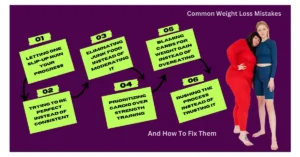Are you struggling with weight loss despite your efforts? You might be unknowingly making some common mistakes that sabotage your progress. This guide will explore six common weight-loss pitfalls backed by science and provide actionable solutions to help you achieve lasting results.
Thank you for reading this post, don't forget to subscribe!How to Understand Mistakes Preventing Weight Loss
& Fix
When you burn more calories than you consume, you lose weight. However, other essential elements include diet quality, consistency, and metabolism. Many people unknowingly fall into traps that hinder their advancement. Let’s examine the most prevalent ones and how to resolve them.
There are tips to understand and follow:
Mistake #1: Letting One Slip-Up Ruin Your Progress
Why It is a Problem
One treat or missed workout frequently triggers remorse and causes one to give up one’s strategy. This all-or-nothing mindset hampered long-term growth by producing a cycle of bingeing and restricting.
How to Fix It
- Adopt a Growth Mindset: View setbacks as learning experiences, not failures.
- Practice self-compassion. Studies show that self-compassion improves long-term habits and reduces emotional eating.
- Get Back on Track Immediately: One unhealthy meal will not derail your progress—your next choice matters.
- Journal Your Progress: Writing about setbacks helps identify triggers and improve habits.
- Seek Support: A coach or accountability partner can motivate you.
Mistake #2: Eliminating Junk Food Instead of Moderating It
Why It is a Problem
Cutting out all treats leads to cravings, often resulting in binge eating. Total restriction is not sustainable and can create an unhealthy relationship with food.
How to Fix It
- Practice Moderation: instead of eliminating junk food, enjoy it in controlled portions.
- Use the 80/20 Rule: indulge in pleasures 20% of the time and eat wholesome foods 80% of the time.
- Swap for Healthier Options: Choose whole-food alternatives like nuts, fruits, and yogurt.
- Plan Treats in Advance: Schedule indulgences to prevent impulsive overeating.
Flexible dieting has been shown to improve long-term weight management compared to strict restrictions.
Mistake #3: Blaming Carbs for Weight Gain Instead of Overeating
Why It is a Problem
Carbs are often unfairly blamed for weight gain, but excess calorie consumption is the real issue. Eliminating carbs unnecessarily can lead to nutrient deficiencies and low energy levels.
How to Fix It
- Choose Complex Carbs: Whole grains, vegetables, and legumes provide fiber and sustain energy.
- Control Portion Size: Even healthful foods can lead to weight gain if eaten excessively.
- Balance Macronutrients: A diet with the right protein, fat, and carbohydrate mix improves satiety and metabolism.
- Limit Processed carbs: Avoid added sugars and refined grains to prevent blood sugar spikes.
Whole grains have been linked to better weight management and reduced risk of chronic diseases.
Weight Loss Plan Tips: Dos and Don’ts to Ensure Lasting Results
Mistake #4: Trying to Be Perfect Instead of Consistent
Why It is a Problem
Strict diet regimens and rigorous exercise frequently cause burnout. Consistency, not perfection, is the secret to long-term success.
How to Fix It
- Make small, sustainable Changes – Focus on progress, not perfection.
- Set realistic goals. Avoid extreme diets that are impossible to maintain.
- Create a Balanced Routine: enjoyable habits last longer than restrictive ones.
- Avoid Overtraining: Too much exercise without recovery can lead to fatigue and injury.
- Practice mindfulness: being aware of hunger cues prevents impulsive eating.
Research shows that forming small, repeatable habits leads to lasting results.
Mistake #5: Prioritizing Cardio Over Strength Training
Why It is a Problem
Relying only on cardio to lose weight might reduce metabolism and muscle loss, making it more challenging to maintain the weight loss.
How to Fix It
- Incorporate Strength Training: Building muscle increases metabolism and promotes fat loss.
- Combine Workouts: A mix of cardio and resistance training delivers the best results.
- Use Progressive Overload: Gradually increase weights to maintain progress.
- Focus on Compound Movements: Exercises like squats and deadlifts burn more calories and build strength efficiently.
- Stay Consistent: Aim for at least two weekly strength training sessions.
Studies show resistance training preserves lean muscle while dieting, making it essential for weight loss.
Mistake #6: Rushing the Process Instead of Trusting It
Why It is a Problem
Many people expect rapid results and become discouraged when progress is slow. Impatience often leads to extreme dieting, which can backfire.
How to Fix It
Set realistic expectations: Healthy weight loss is 1-2 pounds per week.
- Trust the Process: Sustainable changes take time but yield permanent results.
- Track non-scale victories: celebrate strength, endurance, and energy improvements.
- Practice Patience: Weight loss is a marathon, not a sprint.
- Stay Motivated: Focus on overall well-being, not just the scale.
Gradual weight loss leads to better long-term weight maintenance than rapid dieting.
FAQs on Weight Loss Mistakes
Q. What is the most significant mistake people make when losing weight?
The biggest mistake is expecting quick results and giving up too soon. Many people follow extreme diets that are hard to maintain, leading to yo-yo dieting. They also focus too much on cutting calories instead of building sustainable habits. Over-restricting food groups can cause nutrient deficiencies and cravings.
Ignoring strength training is another mistake; it helps maintain muscle and metabolism. Lack of patience leads to frustration and quitting before seeing progress. Sustainable weight loss requires consistency, balance, and realistic expectations.
Q. What is the 2 2 2 method of metabolism?
The 2 2 2 method involves strategic fitness and nutrition habits to boost metabolism. It suggests drinking 2 liters of water daily for hydration and digestion. Consuming at least two servings of protein helps maintain muscle mass. Engaging in strength training at least 2 times a week enhances fat burning. Prioritizing two rest days allows recovery and prevents overtraining. It’s designed to create a balanced approach to fitness and nutrition. By following this method, the body can efficiently burn calories and sustain energy levels.
Q. What are the seven tips for weight loss?
- Focus on whole, unprocessed foods to fuel your body with essential nutrients.
- Stay hydrated by drinking plenty of water to support digestion and metabolism.
- Eat protein-rich meals to keep you full and prevent muscle loss.
- Incorporate both strength training and cardio for balanced fat burning.
- Get quality sleep to regulate hunger hormones and improve recovery.
- Manage stress effectively to prevent emotional eating and cravings.
Be consistent—small, daily habits lead to long-term sustainable results.
Q. What is the 30/30/30 rule for weight loss?
The 30/30/30 rule focuses on starting the day with a structured routine. It suggests consuming 30 grams of protein within 30 minutes of waking up, which helps regulate hunger hormones and prevents energy crashes. The second part includes engaging in 30 minutes of low-intensity exercise. Walking or light cardio keeps the metabolism active without stressing the body. This method stabilizes blood sugar, supports muscle retention, and promotes fat loss. It’s a simple yet effective approach to weight management.
Q. How to get slim in 7 days?
While extreme weight loss in 7 days isn’t sustainable, healthy habits can help. Start by reducing processed foods and focusing on whole, nutrient-dense meals. Drink more water to reduce bloating and support digestion. Incorporate daily workouts, including both strength training and cardio.
Prioritize fiber-rich foods to keep you full and regulate your appetite. Avoid sugary drinks and excess sodium to minimize water retention. Get enough sleep to prevent cravings and hormonal imbalances. Stay consistent, and small changes will lead to noticeable results.
Q. How to burn belly fat?
Burning belly fat requires a combination of diet, exercise, and lifestyle habits. Focus on a balanced diet rich in lean protein, fiber, and healthy fats. Strength training builds muscle, which helps burn fat more efficiently. Cardio exercises like running or cycling improve calorie burn and metabolism.
Reduce sugar and refined carbs to prevent insulin spikes and fat storage. Manage stress through mindfulness or yoga to lower cortisol levels. Prioritize quality sleep, as poor sleep increases belly fat accumulation. Stay patient—consistency is key to long-term fat loss.
Final Thoughts on Weight Loss Mistakes
Avoiding these six typical blunders can significantly enhance your weight loss achievements. Remember that making consistent, long-lasting decisions is more important for weight loss than striving for perfection. Celebrate every little accomplishment, have patience, and trust the process!
Summary of Key Takeaways
- One mistake will not ruin progress—keep moving forward.
- Moderation is better than elimination—enjoy treats in balance.
- Carbs are not the enemy—portion control is key.
- Consistency beats perfection—small habits matter.
- Strength training is essential—do not rely on cardio alone.
- Sustainable weight loss takes time—trust the journey.
Read more articles on Health and Wellness Tips.
You might like to read:
10 Powerful Personal Growth Activities to Reach Your Full Potential



